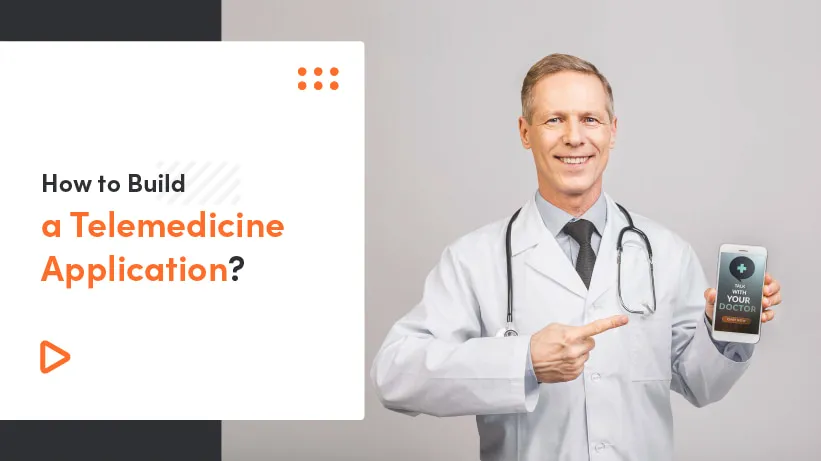The start of 2020 was not what most of us pictured it would be. And while the world is going through changes, there have been a few revelations on some gross inadequacy in the healthcare sector. But as developers, this brings forth a new challenge to overcome. One of the ways to relieve and assist the Healthcare industry is by providing viable solutions. The creation of a telemedical application is just such a solution.
Why build a Telemedicine app?
Digital technologies enable better engagement, improve access to healthcare providers and help build more personal two-way relationships between doctors and patients, telehealth, in particular, has introduced “care anywhere” models, enabling faster, more convenient healthcare servicing. This helps to deliver medical help to the most secluded corners of the world.
Benefits of Telemedicine App Development
The main goal of telemedicine is to provide help and support for the healthcare system across patients, doctors, and medical establishments. Telemedicine services can include such things as providing remote doctor visits, increasing medical service efficiency, and monitoring health conditions from a distance.
Telemedicine Benefits for Patients

Convenient
One of the key benefits here is the ability to not worry about having to make a trip to the hospital. You can access a doctor anywhere anytime and get medical attention when needed. Moreover, it becomes even more vital when talking about parents with small kids or older adults, where just scheduling a medical visit is a task in and of itself.
Saves time
We have all experienced the long wait times for non-emergencies you have to endure when taking a visit to the doctor's office. Even when an appointment has been set there can still be considerable delays.
According to the USA survey of physician practices, the average time for new patients to see a doctor is 18,5 days, and, in some areas, waiting time can reach 72 days. When patients need to get medical consultation, it is urgent for them, and they want to get it as fast as possible, so more than 18 days doesn’t seem fast at all.
Moreover, the patient’s condition can dramatically change while waiting for a visit.
With the ability to simply schedule a voice or video call using in-app functions, the amount of wait time is drastically reduced.
Saves money
It is typically more expensive to show up for a doctor's appointment than to schedule one using a telemedical app. According to the research, people are often opting for telemedicine not to use emergency services in the hospital, as it is by far more expensive than a scheduled visit. As research states, net savings range from $19 to $121 per visit compared with other care providers, assuming that the average cost per a ‘tele’ visit at the time was about $70.
Broader consultation
For most residents within a given geographical location, their only medical options are those available at their local hospitals but with telemedicine, this barrier no longer exists as they can opt for a specialist outside their region.
Telemedicine Benefits for Doctors
Flexibility
We all know that time is very precious for a practicing doctor and being able to give a specified timetable of availability is crucial. Entering online practices, doctors can open time-slots when they are available, improving work-life balance and decreasing stresses.
Improves clinical workflow
Clinical workflow efficiency can be increased. Telehealth serves as the conduit for quicker prioritization of each case and improves communication by capturing, storing, and using patient data for better decision-making.
Increases patients’ engagement
One of the best ways for Physicians to expand their practice without overwhelming themselves is through telemedicine. It allows them to help more people in the most secluded corners of the world. Being convenient, telemedicine may also incentivize patients to seek medical help more often. Moreover, it can cut down no-shows, resulting in better time management.
Reduces overhead
Having patients access care over telemedical apps saves on hospital overhead as it would reduce the cost of dealing with patients in-house for non-emergency cases. This frees up resources to tackle other needed sectors of care.

What are the key features of telemedicine application?
When building a telemedical app, there are a few standard elements to include during the development, but there are also some specific features that make a telemedicine application for healthcare different from other types of wellness software. Below is a review of the features of a telehealth platform.
User Profile
A patient should be able to glance at their information as needed. Hence a user profile is an essential element displaying user’s data. This data can be made up of a display picture (optional), address, gender, location, time zone, email, phone number and alternative numbers for account setting or emergency. It should also display the history of visits and any upcoming appointments.
Patient Web/Mobile Panel
Typically includes the panel of doctor’s services with the list of health conditions subject to treatment and the form for scheduling appointments. A typical set of tabbed pages includes medical, mental, and family health history, lifestyle page, payment methods, settings, and patient activity on the platform.
Geolocation
Telemedicine apps are designed for patients to avoid travel. For this reason, they always request the user’s geolocation to find pharmacies and hospitals nearby, give directions, and set an approximate time of arrival to the selected destination.
Communication Methods
To ensure control of treatment and real-time communication, the focus should be on the integration of live chat and video sessions.
The task for a development team is to build an easy-to-use messenger with file sharing, audio, and video support to keep a high quality of files sent and provide a smooth connection.
Electronic Medical Records (EMR)
Nothing is more vital than having accurate records of a patients' medical history. Hence a telemedical app development requires the integration of EMR to ensure flexibility of workflow and accessibility of data.
The principle of EMR lies in entering data on a new patient and updating it with every new visit. It facilitates further diagnostics of a patient by giving a follow-up of the patient’s condition. EMR organizes all information related to the health condition, reduces the doctor’s paperwork, and prevents duplication of health records.
EMR helps to handle security issues. The system is based on the blocks of data that can be accessed on different levels for different specialists. For example, the whole patient’s record card is viewed by an attending physician only. The other medical staff providing additional services to a patient can solely work with particular blocks of information inside the record. So, the task of a development team is to provide a secure structure of data access and storage for both patients and care practitioners.
Remote Patient Monitoring (RPM)
Some platforms are developed to help patients cope with conditions requiring self-monitoring. They involve RPM to help patients and physicians keep pregnancy records and guide the maternity program or manage chronic conditions that require, for instance, cholesterol or glucose monitoring, etc. Developers also work on RPM-based apps that help people fight severe diseases like cancer and improve their quality of life.
Symptom Checker
A symptom checker works as an auxiliary program that helps patients define their symptoms and answer questions concerning their current general condition. Based on the data entered, the program suggests the list of possible diagnoses, but only a physician makes a final decision.
Prescription and Medication Tracker
When a doctor recommends a prescription, the inbuilt tracker informs a patient when it's ready for pick up at the pharmacy. A patient then must present their ID, insurance card, and the electronic version of a prescription.
Your app can go one step further by integrating an online pharmacy or marketplace, just like in one of our previous projects. Also, your application can include functionality that will give patients an opportunity to get purchased medications via home delivery. This functionality is useful when patients have special needs and are unable to pick up a prescribed medication from a pharmacy by themselves.
Payment Modes
The payment methods vary from app to app, but if you follow Doctor on-demand examples, there are several ways to pay for telemedicine services like: Credit card, Insurance (Medicare or Medicaid plans), Employer coverage and coupons.
Technology used in Telemedicine App Development

The technologies that find great application in telemedicine app development include:
Artificial Intelligence - AI is being increasingly adopted by most telemedicine applications. Using language processing, chatbots, voice recognition, and machine learning lends a new experience to healthcare services.
Big Data - lots of information is generated and proсessed in healthcare. By utilizing big data computations, it is possible to gather and evaluate EHRs (electronic healthcare records). This info can be used to improve treatments, provide more accurate diagnoses, conduct medical researches, and eventually cut costs.
Blockchain - this technology excludes loss of healthcare data as opposed to paper records. Blockchain provides the opportunity to store and exchange medical data securely.
IoT - telemedicine equipment includes tablets, medical kiosks, digital cameras, smartwatches, etc. The Internet of Things contributes to vitals tracking, diagnosis, treatment suggestions, medication adherence, built-in emergency response systems, and more. The combination of medical hardware and software eventually leads to better patient care.
Development workflow
In most cases when building a telemedical solution, it is best to list out the basic workflow from start to finish. Then use this to create milestones needed. Such workflow can look something like this:
- Define the exact target audience
- Identify the purpose of the app
- Develop a business plan for the project (incl. revenue streams)
- Create reliable app content and organize the data
- Plan the budget for telemedicine app development and marketing expenses
- Apply for investments
- Design and implement a product with a team of professional software developers
Telemedicine app development process
To go into further details, once you have decided on what exactly your app is to do and how it's to go, we can start the process of getting everything ready and start the ball rolling.
Business analysis & software architecture planning
This may include optional services such as market and competitor analysis. The compulsory part of this stage is to create a product backlog with a precise description of app functionality, system logic, and project architecture.
UX/UI design
App designs are created on the basis of a product backlog and the telemedicine app concept.
Coding

This is where the programming language of choice is used to create the telemedical application. The stage may concentrate on delivering the first app version with core features in order to release it to the market more quickly and then build further versions. Alternatively, it is possible to implement a fully-featured telemedicine platform at once.
All of the above depends on your business goals, but in any of the cases, the development company allocates a team of required tech specialists - iOS and/or Android developers, back-end developers, and QA engineers to ensure high-end product quality.
Telemedicine Application Business Model - Which is Better?
To develop a telemedicine project plan you also have to define a business model that will be economically sustainable and successfully address challenges. There is no one-size-fits-all approach for any telemedicine company and you have to tailor your offering to fit the needs of the community or market segment you want to service and comply with state and federal laws.
The business model can pursue various motivations for the business, for example, AMD Global Telemedicine lists three possible models a telemedicine business can choose from:
Access to the Care Model: This model deals with care delivery “in remote locations or to populations that do not have care available to them due to geography or limited resources”.
Cost Savings Model: The goal of this model is to provide alternative care delivery methods to reduce costs (by eliminating transportation costs and sharing resources between hospitals).
Access to the Market Model: This model allows expanding the market covered by a healthcare provider and delivering services and expertise over a greater distance.
The Telemedicine Magazine defines three non-traditional, yet successful, telemedicine business models
Institution-to-institution model - An academic medical center can offer the expertise of its specialists to patient markets outside its location. This medical center can sign contracts with rural hospitals or other institutions that need on-demand specialty expertise. Compensation methodologies can include a monthly rate, a hybrid payment, a fee schedule menu of different specialist services, etc. This model can be built independently of an external FFS reimbursement.
Accountable Care Organizations (ACOs) providing telehealth services - Telemedicine technology companies and startups can provide ACOs with services adding quality and improving costs for the prerequisites needed for ACOs to receive Medicare incentive payments.
Offering care for employer workforces - A telemedicine provider can offer telemedicine-based care to the workforce of an employer through a combination of an on-site kiosk and an online app. The compensation approaches here can include a per-encounter fee, a base services rate combined with a reduced per-encounter fee, a fully capitated per employee per month payment, a shared savings fee model, etc.
When considering your business model and telemedicine strategic plan you should clearly define 9 building blocks of your business model:
- Customer segments (those individuals or organizations who pay for your telemedicine service)
- Value proposition (both economic and social)
- Channels for value delivery (internet, telephone or both)
- Customer relationships (the ways to create a positive relationship between provider and customer)
- Revenue streams (where you will receive money from)
- Key resources (technology, software, infrastructure, human resources necessary for delivering value)
- Key activities (what you need to do to deliver value to your customers)
- Key partnerships (partners necessary to create and deliver value, for example, an outsourced IT company who will create apps for your services)
- Cost structure (all costs of your company to provide services, including telemedicine startup costs)
Telemedicine Apps Market Size
The telemedicine market is getting momentum. It is forecasted to exceed $30.5 bln by 2025 rising from $38.3 bln in 2018, as stated by Global Market Insights. Such an increase, by almost 19% is supported by the same growth in the web/mobile telemedicine services delivery model.
The highest market growth is expected in the USA, reaching $64.1 bln by 2025, making this country the largest telemedicine market. Government policies, coupled with the advanced tech infrastructure, will support this trend.
Key market players both enterprises and startups have already proven their interest in the telemedicine segment by making investments and acquisitions.
The telehealth market is growing, as both patients and medical providers get interested. With the growth in the market, comes the increase in demand for building infrastructure to support the industry. This demand is making web and mobile telemedicine app the best way to deliver video consultations.
Some of the most famous examples of telemedicine apps that are already in the market: Doxy Me, AMC Health, swyMed, Teladoc, Mend, eVisit, Sherpaa, MDLIVE, Lemonade, LiveHealth, Doctor On Demand, etc.
General Challenges of building a telemedical app
Even though the telemedicine industry is highly profitable, it has its own challenges. Ignoring them can make your app not user-friendly at best and vulnerable to hackers at worst.
An eye for Design
UI/UX design is a challenge because a telemedicine app has to be highly functional, clear, and accessible for people with disabilities. This means that features such as voice control would be a good fit for a telemedical app. Plus a layout that looks good with fonts of different sizes and different colour palettes. Telemedicine app design should be clear and accessible for people with physical impairments. Also, telemedicine applications have two types of profiles: for doctors and for patients. When creating a design, you should pay attention to these differences and approach the design from the user’s perspective.
Security
This is the most important issue that telemedicine apps face, as they involve sensitive information. Patients want to know that their information is safe and secure at all times. To make your app secure, encrypt and obfuscate all personal data you send and receive, and use third-party servers that are compliant with all applicable laws and regulations in your target country.
Legal Challenges of building a telemedical app
The challenges that make a telemedicine doctor’s app harder to develop concern the restrictions imposed because of healthcare laws. There’s still uncertainty about the patient’s privacy protection. Legal restrictions vary on the state and federal levels. Henсe, the focus is on cybersecurity and HIPAA (Health Insurance Portability and Accountability Act) compliance for the US citizens or GDPR (General Data Protection Regulation) compliance for EU residents, and the respective Acts applicable in other countries.
Local Legislation

By US law, the security is provisioned by HIPAA. Since the gathered data can be stored and forwarded, HIPAA Security Rule states that private health information must be sent through secure messaging. Media files and documents must be encrypted and cannot be spread outside the private network.
By European law, the app must be compliant with GDPR. Article 25 and Recital 78 of the GDPR provide that data protection must be ensured by design and by default. Data protection by design involves:
Pseudonymization - a substitution of personal data elements by artificial identifiers;
Encryption - changing a code to make it readable only for users with permitted access. Data protection by default implies that the user’s health information will be accessible and processed only for a specific case. This includes the amount of personal data collected and the time of its processing, storage, and accessibility.
HIPAA vs. GDPR compliance picture
GDPR is not specific about the methods of provision of those requirements, but they have to be implemented unconditionally. Both GDPR and HIPAA put more responsibilities on organizations and support the rights of a healthcare consumer.
International Care Provision
A telemedicine application for healthcare can’t go global because of different regulatory systems around the world. However, you can allow a patient to start a visit when they are out of the area where service is provided without limitations. The only condition is that a care provider can only advise on treatment and medication, but in no way they can write a prescription. In that case, a patient is the one who’s entirely responsible for the decision to start treatment and its repercussions.
Doctor-Patient Legal Relationship
The privacy issues in a doctor-patient relationship might concern:
Patient credentials. According to some laws, doctors must ask a patient to present their ID before the examination and sign the consent to treatment before prescribing a medication. Practitioner’s license. Doctors providing services through your app must have a GP or respective specialist license in the area where a patient lives.
Malpractice insurance. Ask providers whether their malpractice insurance covers the telemedicine service cases and if it’s viable within the area you’re intended to cover.
How much does it cost to Build Telemedicine Application?
The various possible features that such an application can have, make giving definitive pricing for such apps very difficult. According to rough estimates, the average price range would start from $30k USD.
What sets the price is a combination of a few key factors:
- The set of features that your solution would have. The level of complexity required.
- What platform do you choose to build on. Note here that the more platforms selected the more the app would cost. Such as building for both Windows and Android.
- Developer fees, depending on the location of your developer, this cost might be higher or lower than your base country.
- The technology used alongside third-party services that might be required.
When you are choosing a healthcare mobile/web application development company you will get a rough estimation of the work to be done and the price. Plus always ensure you know the developers billing for after deployment management or maintenance.
If you are interested in finding out more, feel free to reach out.




